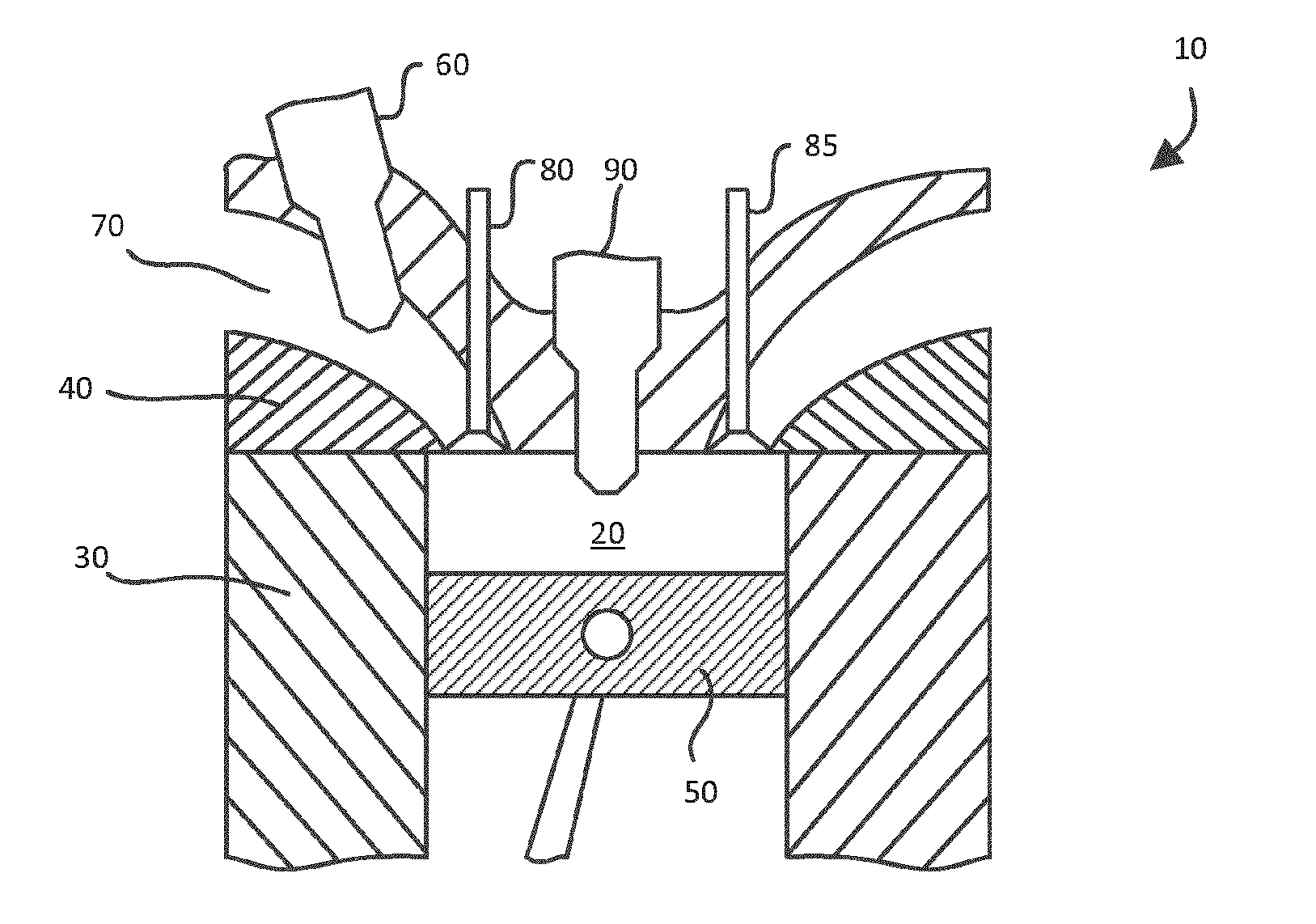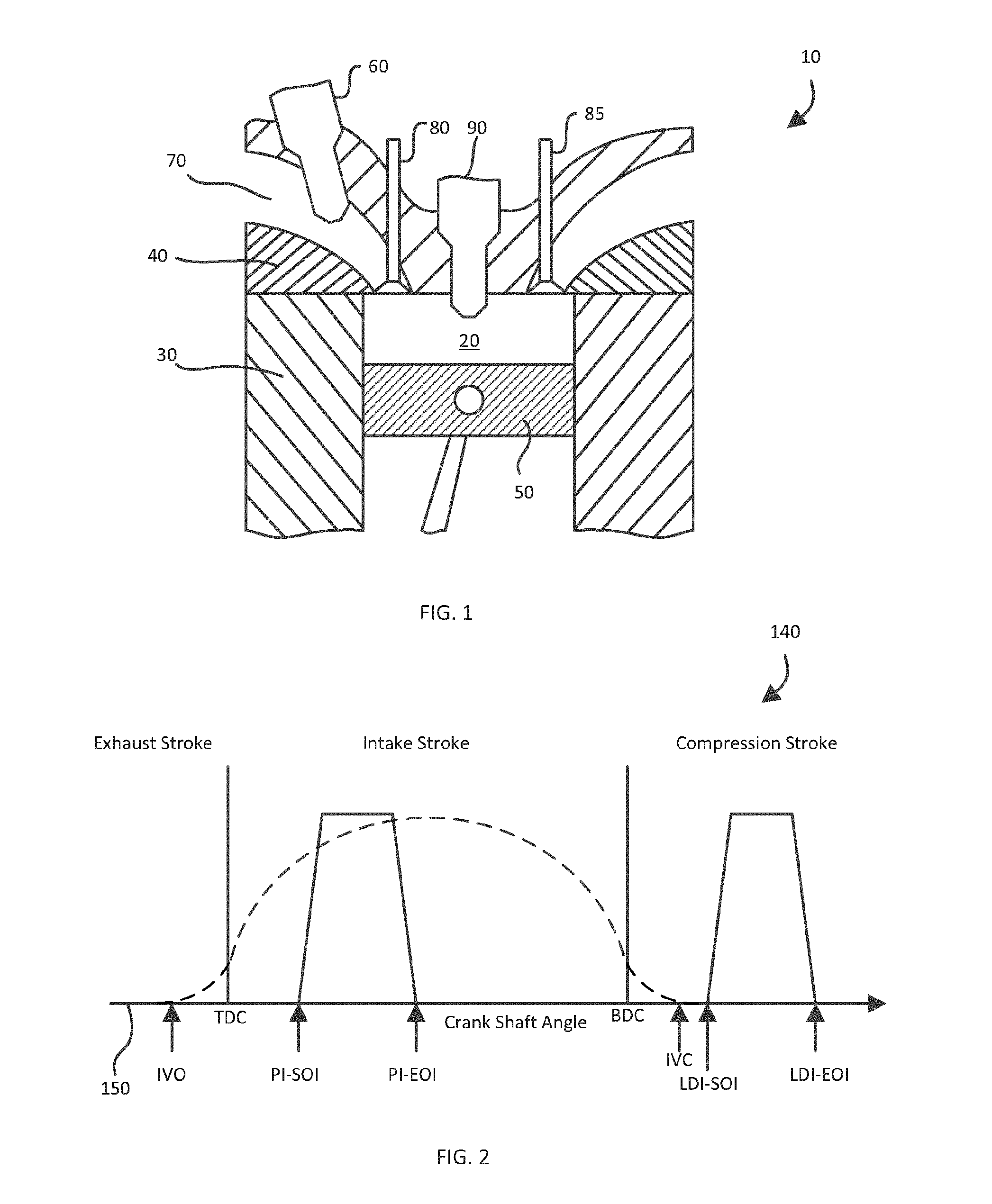Mid-Cycle Fuel Injection Strategies
- Summary
- Abstract
- Description
- Claims
- Application Information
AI Technical Summary
Benefits of technology
Problems solved by technology
Method used
Image
Examples
first embodiment
[0031]a technique for introducing gaseous fuel to an internal combustion engine is illustrated in FIGS. 1, 2, 3 and 4. With reference to FIG. 1, engine 10 comprises combustion chamber 20, which in this example is defined by cylinder wall 30, cylinder head 40 and piston 50. Only one cylinder is shown in FIG. 1 although engine 10 normally comprises two or more cylinders, and the technique disclosed herein applies to engines having one or more cylinders. Port fuel injector 60 introduces gaseous fuel to intake manifold 70 upstream of intake valve 80 such that a charge of at least air and gaseous fuel is sucked into combustion chamber 20. Direct fuel injector 90 directly introduces gaseous fuel to combustion chamber 20. In the present embodiment engine 10 comprises a throttle (not shown) employed to control the intake of air into combustion chamber 20. In other embodiments engine 10 can comprise liquid fuel injectors that introduce a liquid fuel, such as gasoline, directly into combustio...
second embodiment
[0041]Referring now to FIGS. 5 and 6, and first to FIG. 5, a technique for introducing gaseous fuel to an internal combustion engine is illustrated where like parts to the previous embodiment have like reference numerals and may not be described in detail, if at all. Direct fuel injector 91 introduces gaseous fuel to combustion chamber 20. Engine 11 in the present embodiment is operated, similar to the previous embodiment, according to at least one of engine maps 100 of FIGS. 3 and 4. Engine cycle event line event line 141 of FIG. 6 is similar to that of FIG. 2, and the fueling strategies in regions A, B and C of the present embodiment are similar to the previous embodiment. Injector 91 can function to introduce gaseous fuel during the intake stroke and alternatively, or in addition to, during the compression stroke. When introducing fuel during the intake stroke, direct fuel injector 91 starts introducing gaseous fuel at early direct injection-start of injection (EDI-SOI). Early di...
third embodiment
[0044]Referring now to FIG. 7, a technique for introducing gaseous fuel to an internal combustion engine is illustrated where like parts to the previous embodiments have like reference numerals and may not be described in detail, if at all. Engine cycle event line 142 can be employed with engine 10 in FIG. 1 and with engine 11 in FIG. 5. When used with engine 10, PI-SOI and PI-EOI are employed, and when used with engine 11, EDI-SOI and EDI-EOI are employed, according to the fueling strategies discussed previously. Intake valve closed (IVC) occurs during the intake stroke before bottom dead center (BDC) in this embodiment. Closing intake valve 80 before BDC results in an over-expanded cycle where the effective expansion stroke is longer than the effective compression stroke. In a normally aspirated engine this would result in a reduction of power because less air (oxygen) is introduced to combustion chamber 20 during the intake stroke. To offset this power reduction, a turbo-charger ...
PUM
 Login to View More
Login to View More Abstract
Description
Claims
Application Information
 Login to View More
Login to View More - R&D
- Intellectual Property
- Life Sciences
- Materials
- Tech Scout
- Unparalleled Data Quality
- Higher Quality Content
- 60% Fewer Hallucinations
Browse by: Latest US Patents, China's latest patents, Technical Efficacy Thesaurus, Application Domain, Technology Topic, Popular Technical Reports.
© 2025 PatSnap. All rights reserved.Legal|Privacy policy|Modern Slavery Act Transparency Statement|Sitemap|About US| Contact US: help@patsnap.com



